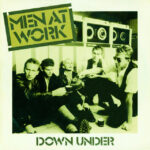 Men at Work’s “Down Under,” released in 1981 on their debut album Business as Usual, is one of those rare songs that transcends its era to become a defining anthem of place, identity, and quirky storytelling. With its instantly recognizable flute riff, buoyant rhythm, and Colin Hay’s charismatic vocals, the song became a global hit and cemented the band’s place in rock history. Yet beyond its catchy hooks and sing-along charm, “Down Under” carries a subtle complexity—a blend of social commentary, cultural pride, and playful irony—that rewards close listening even decades after its release.
Men at Work’s “Down Under,” released in 1981 on their debut album Business as Usual, is one of those rare songs that transcends its era to become a defining anthem of place, identity, and quirky storytelling. With its instantly recognizable flute riff, buoyant rhythm, and Colin Hay’s charismatic vocals, the song became a global hit and cemented the band’s place in rock history. Yet beyond its catchy hooks and sing-along charm, “Down Under” carries a subtle complexity—a blend of social commentary, cultural pride, and playful irony—that rewards close listening even decades after its release.
A Sound That Defines an Era
From the opening bars, “Down Under” announces itself with a jaunty, almost whimsical energy. The flute riff, played by Greg Ham, immediately sets the song apart, lending it an air of innocence and nostalgia. It’s a melody that is both playful and instantly iconic, capturing attention in a way that few instrumentals in rock pop ever manage. Behind it, the tight rhythm section—John Rees on bass and Jerry Speiser on drums—provides a steady, propulsive foundation that balances the song’s lighthearted surface with musical sophistication.
Colin Hay’s guitar work complements the flute perfectly. His strumming patterns are bright and crisp, reinforcing the song’s sense of movement and journey. The instrumentation works in concert to evoke imagery of open landscapes, sunny skies, and endless roads—a fitting musical backdrop for a song that is as much about a country as it is about the people within it.
Vocals with Character
Colin Hay’s voice is central to the song’s charm. There is a warmth and casual charisma in his delivery that feels both intimate and inviting. He sings as if he is sharing a story with a friend, balancing humor, pride, and a gentle self-awareness. His articulation and phrasing make every line memorable, while his slight Australian accent adds authenticity and cultural specificity to the performance.
Hay’s vocal control allows the song to maintain energy without ever feeling forced. The chorus, in particular, is a masterclass in sing-along phrasing—open, melodic, and immediately accessible. Yet even within the cheerful delivery, there is a subtle satirical edge that hints at the deeper commentary woven into the lyrics.
Lyrics: Pride, Humor, and Subtle Commentary
While “Down Under” is often celebrated for its catchy chorus and whimsical imagery, its lyrics are far more nuanced than they might first appear. On the surface, the song paints a picture of Australian culture, highlighting iconic foods, slang, and imagery that would resonate with both locals and international listeners. Lines about Vegemite sandwiches, traveling through cities, and meeting diverse people give the song a sense of playful storytelling rooted in real experiences.
Beneath this charm, however, there is social commentary. The song touches on themes of identity, globalization, and cultural change. References to Australians traveling abroad and encountering foreign perceptions of their homeland suggest an awareness of how culture and place are both celebrated and misunderstood. The playful tone masks a sharper observation about pride, belonging, and the way national identity is navigated in a modern world.
This duality—fun and reflective—helps the song endure. Listeners can enjoy it on a purely musical level, whistling along to the flute riff, while those who dig deeper can appreciate the subtleties of its lyrical content.
Instrumentation and Musicality
“Down Under” is deceptively simple in structure, but its musicality is precise and layered. The song relies heavily on its flute hook, which serves both as an introduction and recurring motif throughout. It is unusual in rock-pop songs of the era to feature such a prominent wind instrument, yet it works seamlessly here, giving the song a distinct texture.
The rhythm section is understated but essential. The bass lines provide a walking foundation, keeping the momentum moving forward without overshadowing the melodic instruments. Drums maintain a crisp, mid-tempo groove, punctuating transitions and choruses with subtle fills that enhance the song’s dynamic range.
Guitar work complements the flute and vocals with rhythmic strumming and occasional melodic flourishes. Each instrument is given space to breathe, allowing the interplay to remain clear and balanced. This restraint ensures that no single element dominates, creating a cohesive sound that is instantly recognizable.
Chorus: A Global Anthem
The chorus of “Down Under” is one of the most instantly recognizable in rock history. The combination of melody, rhythm, and lyrical imagery creates an infectious hook that invites sing-alongs. The whistled flute line is practically synonymous with the song itself, functioning as both melody and motif, and it has contributed to the song’s enduring appeal in popular culture.
What makes the chorus so effective is its universality. Even without knowing every lyric, listeners from across the globe can engage with the song, feeling the joy and energy it conveys. The anthem-like quality of the chorus contributes to the track’s international success, making it a cultural ambassador for Australia and Men at Work alike.
Cultural Context and Impact
When “Down Under” was released, the Australian music scene was gaining international attention, and Men at Work played a significant role in bringing it to the global stage. The song’s international success was unprecedented, topping charts in the United States, Australia, and the United Kingdom. It became more than a hit; it became a symbol of Australian culture abroad, embodying a playful, self-aware national identity.
Beyond its commercial impact, the song has also influenced generations of artists. Its blend of rock-pop, light instrumentation, and narrative storytelling paved the way for future bands seeking to incorporate cultural specificity into mainstream music. “Down Under” showed that local identity could be celebrated without alienating international audiences—a delicate balance that few songs achieve with such flair.
The Humor Factor
One of the most charming aspects of “Down Under” is its sense of humor. The song doesn’t take itself too seriously, and this playfulness makes it accessible and enduring. The lyrics contain whimsical references, while the melody maintains a sense of buoyancy and joy. This humor complements the song’s commentary, allowing it to explore themes of identity and pride without feeling preachy or heavy-handed.
Humor also enhances the song’s memorability. The quirky lines, playful phrasing, and unexpected musical flourishes create moments that stick in the listener’s mind. Even decades later, people hum the melody or whistle the flute line, demonstrating the lasting power of lighthearted musical storytelling.
Legacy and Influence
“Down Under” has stood the test of time, both as a representation of Men at Work’s career and as an enduring pop-cultural touchstone. Its blend of catchy melody, quirky instrumentation, and layered lyrics has influenced countless artists in rock, pop, and indie genres. The song continues to be used in films, commercials, and cultural events, often serving as shorthand for Australia itself.
Moreover, “Down Under” highlights Men at Work’s skill as a band. Each member contributes to a cohesive sound that is both distinctive and accessible. Colin Hay’s vocals, Greg Ham’s flute, and the tight rhythm section create a balanced, textured track that is more than the sum of its parts.
The song also demonstrates the power of cultural specificity in music. By embracing Australian imagery and identity, Men at Work crafted a track that was personal, authentic, and globally relatable. Its success proved that celebrating one’s roots could resonate far beyond local borders, a lesson that continues to inform musicians today.
Live Performance Appeal
“Down Under” translates brilliantly to live performance. Its rhythmic energy and catchy chorus make it a crowd favorite, while the narrative storytelling allows for interaction with the audience. Colin Hay’s vocal charisma shines in concert, and the flute and guitar lines provide opportunities for subtle improvisation and instrumental flair.
Live performances highlight the song’s versatility. It can be intimate and acoustic, emphasizing the lyrics and melody, or it can be performed with full band energy, creating a festival-like atmosphere. This adaptability contributes to its longevity and continued relevance in both casual and professional music settings.
Why “Down Under” Endures
The song’s enduring appeal lies in its perfect balance of accessibility and depth. It is immediately engaging, with a memorable melody, infectious rhythm, and playful instrumentation. At the same time, it offers layers of meaning for those who pay closer attention—the subtle humor, cultural commentary, and narrative storytelling add richness that keeps listeners returning over decades.
“Down Under” also endures because of its personality. It embodies a particular time, place, and ethos without feeling dated or inaccessible. Its celebration of culture, humor, and musicality transcends generational boundaries, making it a classic in every sense of the word.
The song’s technical craftsmanship ensures it remains fresh even after repeated listens. Each instrument is clearly defined in the mix, the harmonies are precise, and Colin Hay’s vocals remain expressive and engaging. These qualities, combined with the memorable flute riff and catchy chorus, create a track that is both timeless and immediately recognizable.
Conclusion: A Whistled Journey Across Australia
“Down Under” by Men at Work is more than just a catchy pop hit; it is a masterful blend of storytelling, musicality, and cultural identity. From the iconic flute riff to Colin Hay’s charismatic vocals, the song captures the essence of Australia with humor, warmth, and musical sophistication. Its ability to balance whimsy, commentary, and global appeal makes it one of the defining tracks of the early 1980s and a lasting anthem of identity and pride.
Even decades later, the song’s charm, wit, and musical craftsmanship continue to captivate listeners. It is both a celebration of place and a universally relatable story of journey, discovery, and reflection. “Down Under” remains a testament to the power of well-crafted pop-rock: simple in approach, sophisticated in execution, and endlessly memorable.


